Where travel agents earn, learn and save!
News / European airline capacity: first time back over 50% of 2019
Europe's recent recovery has been led by international capacity

July 5 - Seat capacity in Europe is back above 50% of pre-pandemic levels for the first time since March 2020. In the week commencing June 28, 2021, the continent’s capacity is 46.4% below the equivalent week of 2019.
Moreover, Europe is no longer at the bottom of the league table on this measure, having jumped above the Middle East, where seat capacity is down by 48.5% versus 2019. Asia Pacific is down by 40.0%, Africa by 39.2%, Latin America by 34.0%, and North America by 21.5%.
So far in 2021, Europe has progressed from 27% of 2019 capacity in 1Q2021 to 34% in 2Q2021. The next quarter, 3Q2021, starts with seat numbers at 54% of 2019 for the current week. The improvement from 1Q2021 has been led by international markets, which are more important to Europe than in other regions.
Further recovery will also depend on international capacity much more than on domestic.
With progress towards relaxing international travel restrictions still patchy, the average of 72% of 2019 capacity currently scheduled for 3Q2021 looks optimistic.
Europe has 19.7 million seats vs 36.8 million in 2019 – down 46%
In the week commencing June 28, 2021, total European seat capacity is scheduled to be 19.7 million, according to OAG schedules and CAPA seat configurations.
This is 46.4% below the 36.8 million seats of the equivalent week of 2019 – the first time in 67 weeks that the decline has been less than 50%, and 6.6ppts better than the 53.0% fall a week ago (week commencing 21-Jun-2021).
In absolute terms, the 19.7 million seats scheduled for this week is 15.1% more than in the week of June 21, 2021, and 3.0 million more than in the mid August 2020 peak of last summer.
This week’s total seat capacity for Europe is split between 6.9 million domestic seats, versus 8.1 million in the equivalent week of 2019; and 12.8 million international seats, versus 28.7 million.
Europe’s domestic seats are down by 14.2% versus 2019, compared with last week’s -20.1%.
International seat capacity is down by 55.4% versus 2019, compared with last week’s -62.5%.
Europe: percentage change in weekly airline seat capacity vs equivalent week of 2019
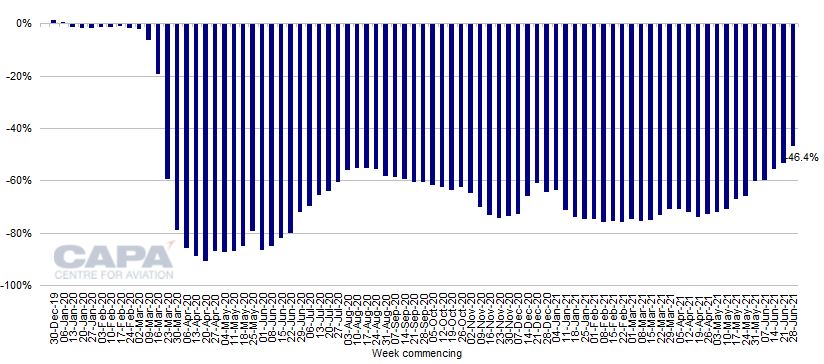
Europe is no longer the weakest region
Europe's 46.4% cut in seat numbers takes it above the Middle East, where seat capacity is down by 48.5% versus 2019 this week (week commencing June 28, 2021). This means that Europe is no longer the worst performing region on this measure, for the first time since October 2020.
Asia Pacific’s seat count is down by 40.0%, Africa’s by 39.2%, Latin America’s by 34.0%, and North America’s by 21.5%.
Europe, North America, Africa and Middle East have taken upward steps in the trend of seats versus 2019 levels this week. Asia Pacific and Latin America have remained broadly level with last week.
All regions are above 50% of 2019 capacity for the first time during the pandemic.
Percentage change in passenger seat capacity vs 2019 by region, week of March 30, 2020 to week of June 28, 2021
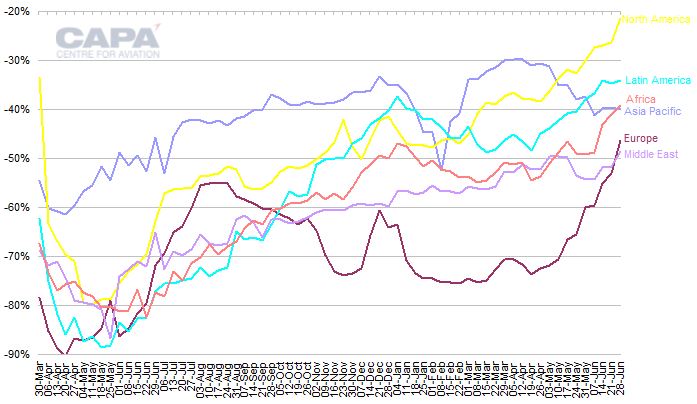
Europe's 3Q2021 schedule is so far proving more resilient than previous pandemic quarters
Scheduled capacity for Europe in 2Q2021 was down by 66% from 2019 levels (i.e. at 34% of 2019 levels, compared with 27% for 1Q2021), according to data from OAG and CAPA.
Schedules for 3Q2021, which starts during the current week, have been trimmed by 1% since last week. Seat numbers for the quarter are now planned to be down by 28% versus 2019.
This is still 72% of 2019 levels, progressing from 54% at the start of the quarter to 81% projected by the end of the quarter.
This average of 72% for 3Q2021 is the highest level planned at the start of any quarter since the start of 2Q2020, when capacity was scheduled to be 73% of 2019. The out-turn for 2Q2020 was just 15%, when many airlines were almost completely grounded as the pandemic was then at its peak.
The outlook for 3Q2021 schedules has not changed much over the past month, falling only a little from 74% to 72% of 2019 capacity in that period.
For previous quarters during the pandemic there has been a much more significant drop in planned capacity from one month before the quarter to the start of the quarter, and then from the start of the quarter as it unfolds.
So far, the data for 3Q2021 indicate that European airlines have hopes for greater resilience in capacity planned for the established peak quarter of the year.
Europe: projected seat capacity as a percentage of equivalent quarter of 2019, one month before quarter start and at quarter start, with final outcome
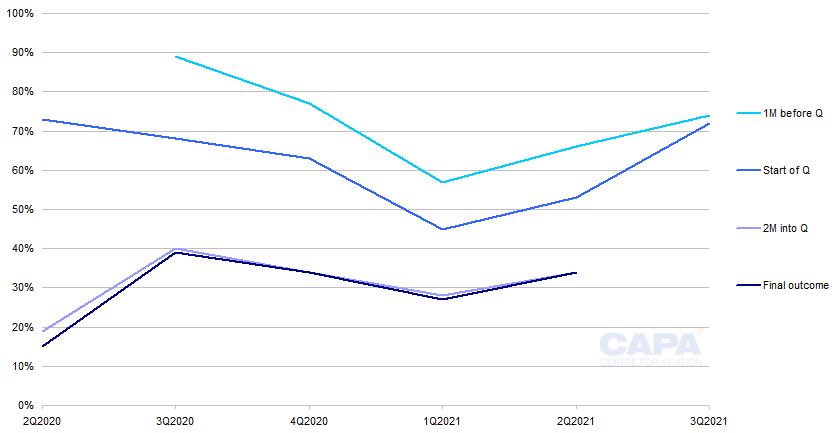
Europe's recent recovery has been led by international capacity
The resurgence in capacity in Europe since mid April 2021 has been led by a recovery in international seats, which were harder hit by the pandemic than domestic capacity. Over the past 10 weeks domestic European capacity has grown 1.8 times, whereas international capacity is up 2.7 times.
International seats’ share of the total has risen from 55% in mid April 2021 to 65% this week, although this is still short of its 77% share in the equivalent week of 2019.
Further growth to the 3Q2021 peak will also depend on additional international seats
Based on schedules currently filed with OAG, the peak capacity week for Europe in 3Q2021 is projected to be the week of September 6, 2021 (also the peak for all of 2021), when a total of 28.4 million seats are scheduled.
This would be 78% of total capacity in the equivalent week of 2019.
This projected total is split between 7.9 million domestic seats and 20.5 million international seats, or 95% of domestic and 73% of 2019 international capacity in the equivalent week of 2019.
International capacity in that week of September 2021 would be 72% of the total – almost back to its 77% share in the same week of 2019.
In order to reach the total projected for that peak week, 10 weeks into the future, only 1.0 million additional domestic seats are scheduled relative to the week of June 28, 2021. This is much fewer than the 3.1 million domestic seats added over the past 10 weeks.
Europe: weekly domestic seat capacity, 2018-2021* (projected)
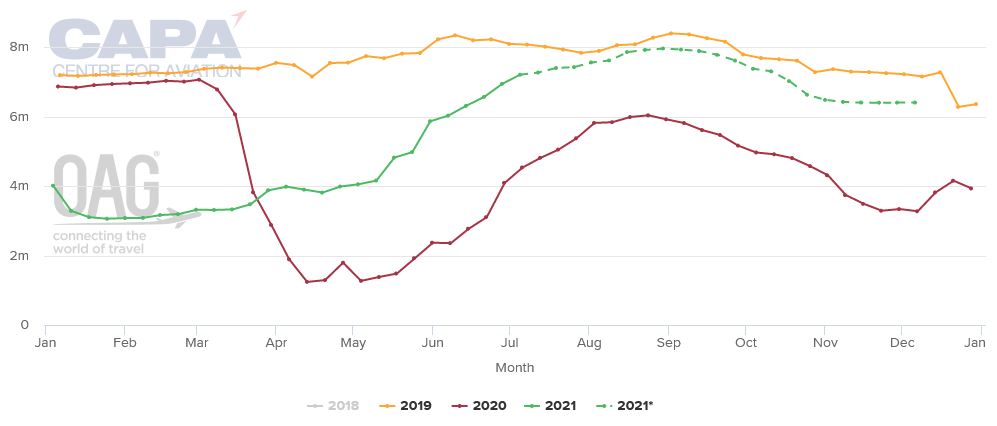
By contrast, 7.7 million international seats are scheduled to be added over the next 10 weeks, almost matching the 8.1 million additional international seats over the past 10 weeks.
Europe: weekly international seat capacity, 2018-2021* (projected)
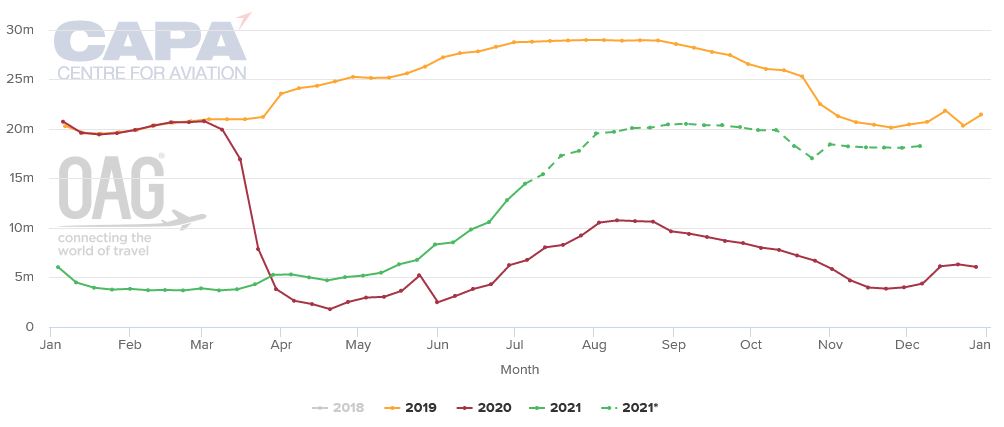
The 72% of 2019 capacity scheduled for 3Q2021 looks optimistic
As noted above, Europe's airlines have been doggedly holding on to their peak summer schedules, their hopes increased by vaccination rollout across the continent.
Just as the recent upturn in European airline capacity has been led by the international recovery, so will the projected growth in 3Q2021 depend largely on continued growth in international markets.
In turn, this depends on further relaxation of international travel restrictions. There has been some progress in this recently, but it remains piecemeal. The currently scheduled 72% of 2019 capacity for 3Q2021 continues to look optimistic.
More Travel News:
Travelport and Emirates reach agreements on un-surcharged content, NDC distribution and it service extension
TourRadar launches new suite of tools to encourage sustainable travel
St. Kitts & Nevis to remain open to international tourists
Vaccines and digital solutions to ease travel restrictions











